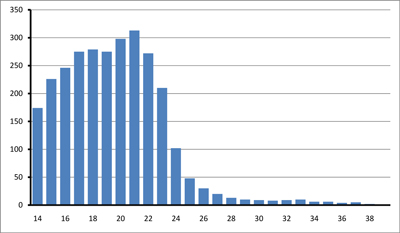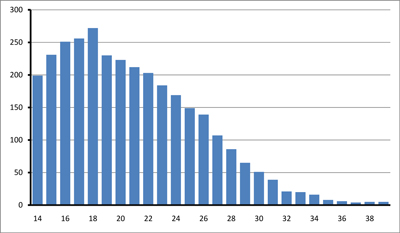Nesting opportunities are often lacking in gardens, especially those associated with the presence of natural cavities. Even so, our gardens still support a large number of nesting birds and, in some cases, they hold important breeding populations of species of conservation concern.
Because of this, we really need to know which species are breeding in our gardens, in what numbers and when. Such information is difficult to collect through annual monitoring projects, such as the Breeding Bird Survey, as these gardens are in private ownership and you cannot just poke your head over the fence to see what they contain! This is where projects like the Garden Nesting Survey come in.
Background
We first carried out the Garden Nesting Survey in 2000, the idea coming from John Tully and Richard Bland - who ran the survey in its initial years. We then decided that 2010 was the ideal time to rerun the survey, overlapping with the Bird Atlas 2007-11 project and allowing Garden BirdWatchers and others to contribute breeding records to the atlas from gardens across Britain & Ireland.
We are very grateful to the John Spedan Lewis Foundation and Gardenature, who helped to fund the set-up of this survey.
Which species were most commonly found nesting?
Over half the gardens which took part in the study reported an active Blackbird nest in at least one week. Blackbirds were probably seen most frequently partly because gardens provide the kind of habitat that they need to nest, and they also have a long breeding season, making multiple breeding attempts across the spring and summer. Their nests are often in fairly conspicuous locations in hedges or creepers, meaning the birds can be quite noticeable when building nests or feeding chicks.
The second most frequently seen species was Blue Tit, with nearly half of gardens recording this species. Gardens also often provide good nesting habitat for Blue Tits, particularly where nest boxes are available. Nest boxes also allow the nesting behaviour of the birds that use them to be observed relatively easily.
GNS and Garden BirdWatch
Many of the top ten species recorded in the GNS were also frequently observed in Garden BirdWatch gardens over the same period. Blackbirds and Blue Tits were the most frequently reported species in both the GNS and by Garden Birdwatchers during spring 2010.
However, a few species (Dunnock, Chaffinch and Greenfinch) were in the top ten in GBW gardens but were not present in the top ten nesting species. These birds may either rarely use gardens to nest (finches), or have nests that are relatively inconspicuous (Dunnock).
In contrast, Wren, Great Tit and House Sparrow nests were found more frequently in the GNS than other species which were more often observed in GBW. Great Tits often use nest boxes, and House Sparrows regularly nest on peoples’ houses, meaning nesting activity may be more easily observed.
The following table shows the top 10 species that were most frequently recorded nesting in gardens in the survey and a comparison with GBW reporting data.
Species | % GNS gardens recording nesting | % GBW gardens reporting (rank) |
|---|---|---|
Blackbird | 51.8 | 96 (1) |
Blue Tit | 46.3 | 88 (2) |
Great Tit | 26.9 | 75 (6) |
Robin | 26.3 | 81 (4) |
House Sparrow | 22.5 | 68 (8) |
Woodpigeon | 20.3 | 88 (3) |
Dunnock | 17.3 | 80 (5) |
Wren | 11.8 | 26 (17) |
Collared Dove | 10.5 | 70 (7) |
Starling | 9.65 | 58 (12) |
What were the birds doing?
When participants entered their information about active nests on the website, they were asked to describe the status of the nest. For most species, nests were most commonly observed either when they were being built or when chicks were present. For example, on 21% of the occasions when an active Blackbird nest was recorded it was being built, and 28% of the time, chicks were present.
Nest building and feeding chicks are two conspicuous activities, when parent birds are busy entering and leaving the nest frequently, in contrast to incubation, when one parent will sit quietly and inconspicuously on the nest for long periods of time.
When were birds observed nesting?
The data collected during the survey allowed us to look at the patterns of nesting activity of different species through time. We expected species like Blue Tit and Great Tit, that generally only have one brood each year, to show a single peak in nesting activity in the spring, and birds would not have been seen nesting much after this.
From the survey data, it is clear that most Blue Tit breeding activity has already begun by week 14 (28th March), and the majority of active nesting attempts are over by week 24 (6th June).
However, species like Blackbird, Robin and House Sparrow can have several broods of chicks each year, and therefore their nesting activity continues over a much longer time period, with reasonable numbers of Blackbird nests still being reported up to mid-July (week 30th).


How did nests fare?
Online participants were also asked to enter an outcome code for each nest that they recorded. From these results, it appears that most nests of common species fledged successfully (although this result may be biased, as it seems likely that people were more likely to record successfully fledged young than those where outcomes were unknown or unsuccessful).
For example, in Blue Tit nests where an outcome was recorded, 71% nests fledged successfully, only 2% were predated and 10% failed for unknown reasons (the outcome was unknown for the other 16%).
What other patterns did we find?
Regional patterns
There were some regional patterns in the occurrence of different species nesting in gardens.
For example, House Sparrows were more commonly found nesting in the north of England and Scotland (27% of gardens) than in the south of England and the Midlands (21% of gardens). This mirrors known population trends for this species, which has declined dramatically in the south and south-east of England, but elsewhere populations are stable or increasing.
Conversely, Robins were more frequently found nesting in the south of England than further north in the country, with 33% of gardens in southern England and 26% of gardens in the Midlands, but only in 18% of gardens in northern England and Scotland reporting nests of this species.
Garden characteristics
We also asked GNS volunteers to record aspects of the habitat in their gardens, and used this to look at associations with species nesting.
Unsurprisingly, cavity-nesting species like Blue Tit and Great Tit were more likely to be seen in gardens with nest boxes, and the more deciduous hedge that was present in a garden, the greater the chance of seeing species like Robin, Blackbird, Dunnock and Wren nesting.
If gardens had an area of wild or unmanaged land, then this increased the likelihood of seeing all species nesting, and also increased the number of species per garden.